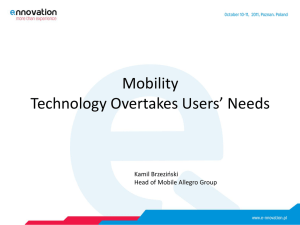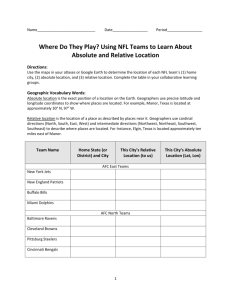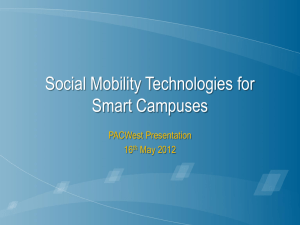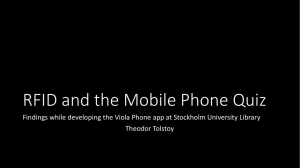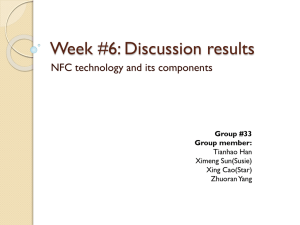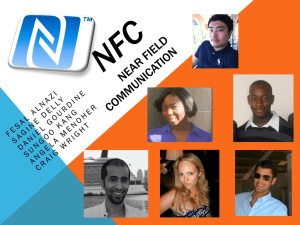A Review on the Operating Modes of Near Field Communication
advertisement
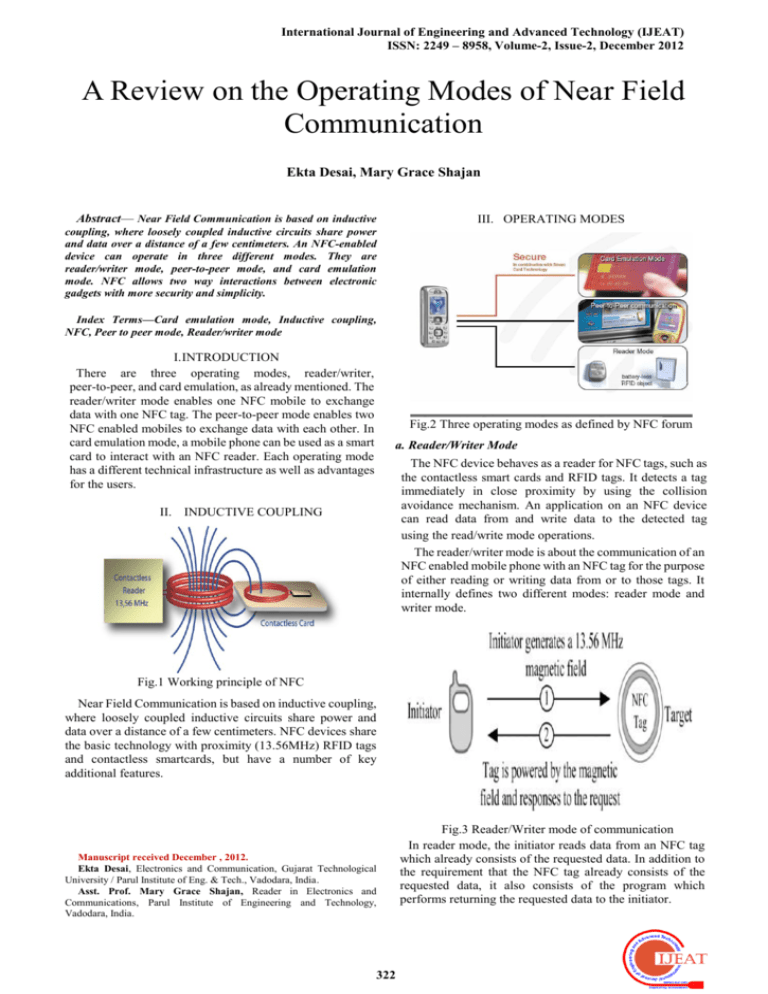
International Journal of Engineering and Advanced Technology (IJEAT) ISSN: 2249 – 8958, Volume-2, Issue-2, December 2012 A Review on the Operating Modes of Near Field Communication Ekta Desai, Mary Grace Shajan Abstract— Near Field Communication is based on inductive coupling, where loosely coupled inductive circuits share power and data over a distance of a few centimeters. An NFC-enabled device can operate in three different modes. They are reader/writer mode, peer-to-peer mode, and card emulation mode. NFC allows two way interactions between electronic gadgets with more security and simplicity. III. OPERATING MODES Index Terms—Card emulation mode, Inductive coupling, NFC, Peer to peer mode, Reader/writer mode I. INTRODUCTION There are three operating modes, reader/writer, peer-to-peer, and card emulation, as already mentioned. The reader/writer mode enables one NFC mobile to exchange data with one NFC tag. The peer-to-peer mode enables two NFC enabled mobiles to exchange data with each other. In card emulation mode, a mobile phone can be used as a smart card to interact with an NFC reader. Each operating mode has a different technical infrastructure as well as advantages for the users. Fig.2 Three operating modes as defined by NFC forum a. Reader/Writer Mode The NFC device behaves as a reader for NFC tags, such as the contactless smart cards and RFID tags. It detects a tag immediately in close proximity by using the collision avoidance mechanism. An application on an NFC device can read data from and write data to the detected tag using the read/write mode operations. The reader/writer mode is about the communication of an NFC enabled mobile phone with an NFC tag for the purpose of either reading or writing data from or to those tags. It internally defines two different modes: reader mode and writer mode. II. INDUCTIVE COUPLING Fig.1 Working principle of NFC Near Field Communication is based on inductive coupling, where loosely coupled inductive circuits share power and data over a distance of a few centimeters. NFC devices share the basic technology with proximity (13.56MHz) RFID tags and contactless smartcards, but have a number of key additional features. Manuscript received December , 2012. Ekta Desai, Electronics and Communication, Gujarat Technological University / Parul Institute of Eng. & Tech., Vadodara, India. Asst. Prof. Mary Grace Shajan, Reader in Electronics and Communications, Parul Institute of Engineering and Technology, Vadodara, India. 322 Fig.3 Reader/Writer mode of communication In reader mode, the initiator reads data from an NFC tag which already consists of the requested data. In addition to the requirement that the NFC tag already consists of the requested data, it also consists of the program which performs returning the requested data to the initiator. A Review on Operating Modes of Near Field Communication peer-to-peer mode. Data are sent over a bidirectional half duplex channel, meaning that when one device is transmitting, the other one has to listen and should start to transmit data after the first one finishes. Fig.4 Generic usage model of reader mode In writer mode, the mobile phone acts as the initiator and writes data to the tag. If the tag already consists of any data prior to the writing process, it will be overwritten. The algorithm may even be designed so that the initiator will update by modifying the previously existing data as well. Fig.5 Generic usage model of writer mode Fig.8 Mobile peer to peer mode with NFC Applications Of Peer To Peer Mode: i) Exchanging Data Critical information can be stored in a mobile device securely and can further be exchanged with other authorized people using peer-to-peer mode. Since the communication is performed over a few centimeters, users will feel confident to share private and important data using NFC technology. When higher level of security requirements is set additional security measures need to be provided as well. ii) Money Transfer Two users can exchange money between wallets that are stored on their NFC mobiles. Gifts, coupons, and tickets can be implemented as exchangeable objects as well. Applications Of Reader/Writer Mode: i) Smart Poster The smart poster term refers to advertising materials or posters that are equipped with NFC tags. Those tags may contain different types of data such as a URL address, a couponing service, an SMS service, and so on. Fig.6 Smart poster exchanges information Smart posters are the most common usage area of the reader/writer mode. ii) Remote marketing iii) Remote shopping iv) Mobile social such as social networking and location based services. b. Peer To Peer Mode Peer-to-peer mode enables two NFC enabled mobile devices to exchange information such as a contact record, a text message, or any other kind of data. This mode has two standardized options; NFCIP-1 and LLCP. NFCIP-1 takes advantage of the initiator–target paradigm in which the initiator and the target devices are defined prior to starting the communication. However, the devices are identical in LLCP communication. After the initial handshake, the decision is made by the application that is running in the application layer. On account of the embedded power to mobile phones, both devices are in active mode during the communication in iii) Social Networking Fig.7 Peer to peer communication The number of applications developed using peer-to-peer mode is less than for other operating modes so far. Peer-to-peer mode is generally used for device pairing, networking, and file transfer operations. Pairing Bluetooth devices, exchanging business cards, and making new friends on online networks are possible implementations of this mode. Peer-to-peer mode provides easy data exchange between two devices. Easy data exchange between two NFC compatible devices provides the possibility for secure exchange of private data. NFC devices can transfer data in a few centimeters, so exchanging private and important data may be one of the key future applications of this mode. The peer to peer mode adds quality functionality to NFC Phones. In this mode, two NFC phones can exchange data with each other when brought to close proximity. For an example, two business partners can transfer their virtual business cards with each other by bringing their NFC-enabled phones close to each other. Another popular usage is for connection handoff to other standard technology; NFC connection can be used to set-up Bluetooth pairing or Wi-Fi setup. After successful setup, the handset can use the 323 International Journal of Engineering and Advanced Technology (IJEAT) ISSN: 2249 – 8958, Volume-2, Issue-2, December 2012 Bluetooth or Wi-Fi connections. this operating mode. c. Card Emulation Mode: Card emulation mode provides the opportunity for an NFC enabled mobile device to function as a contactless smart card. Mobile devices can even store multiple contactless smart card applications in the smart card. The leading examples of emulated contactless smart cards are credit card, debit card, loyalty card, transport cards, identity or access cards. Card emulation mode only removes the need for carrying the cards. People carry mobile phones with them most of the time so coupling mobile phones with the human body fits with their use. One can expect that in the near future people will carry NFC enabled mobile phones not just to gain mobility but also to perform daily functions as well. All credit cards, keys, tickets, and so on will be possibly embedded into mobile phones. Hence, there will be more opportunities to integrate daily objects into NFC enabled mobile phones in the future. iii) Ticketing Ticketing use cases can be implemented in different forms. Users can store different types of tickets such as theater, bus, and flight tickets that have been previously downloaded via smart posters or by some other method. These tickets then can be used in turnstiles or validation points via card emulation mode. Prepaid or monthly ticketing cards can also be stored and used. iv) Access control Access control use cases enable users to store their access control objects in their mobile devices. Examples of these cases include electronic keys for cars, buildings, secure areas, and hotel rooms. Hotel check-in is an interesting use case that enables the room key to be received via OTA technology prior to arriving at the hotel and directly checking into the room. Thus there is no reason to spend time at the reception on arrival in this instance. v) Identity Services Another interesting use case of this mode is storing identity based information on mobile devices and enabling authorized personnel to access it. IV. CONCLUSION Fig. 9 Card emulation mode Three different operating modes are defined in NFC technology; reader/writer mode, peer-to-peer mode, and card emulation mode. Each mode’s usage can be defined with generic usage models. Moreover each mode provides different benefits to users. Reader/writer mode applications can increase the user’s mobility and decrease the physical effort. On the other hand, card emulation mode applications do not promote the mobility property of mobile phones; however, they tightly link users with mobile phones. This mode’s benefits include eliminating physical objects and providing access control. Peer-to-peer mode applications are useful for easy data exchange between users and provide easy device pairing. In this operating mode an NFC enabled mobile phone does not generate its own RF field; the NFC reader creates this field instead. Currently supported communication interfaces for the card emulation mode are ISO/IEC 14443 Type A and Type B, and FeliCa. Card emulation mode is an important mode since it enables payment and ticketing applications and is compatible with existing smart card infrastructure. ACKNOWLEDGEMENT I have taken efforts in this literature review. However, it would not have been possible without the kind support and help of many individuals. I would like to extend my sincere thanks to all of them. I am highly indebted to Prof. Mary Grace Shajan PIET, Limda for her guidance and constant supervision as well as for providing necessary information regarding the project. I would like to express my gratitude towards her for her kind co-operation and encouragement which helped me in completion of this Literature review. I would like to express my special gratitude and thanks to PG Director Mr. P.H. Tandel Sir & the Head of The Dept. Mr. M.A. Lokhandwala Sir, for giving me such attention and time. My thanks and appreciations also go to my colleague in work the project and people who have willingly helped me out with their abilities. Fig.10 Generic model of card emulation mode Applications of Card Emulation Mode: i) Payment There can be different types of NFC payment applications. There is no doubt that the most important payment applications are credit and debit card usage which can be triggered by NFC readers. There are also other opportunities for NFC payment such as storing and using vouchers, using gift cards, and so on. ii) Loyalty Loyalty points can be gained at payment points and can later be used to carry out free shopping or to obtain a gift. Also, coupons that are downloaded via smart posters using reader/writer mode can further be used by NFC readers using REFERENCES [1] [2] 324 Vedat Coskun, Kerem Ok, Busra Ozdenizci, ―Near Field Communication From Theory to Practice‖, NFC Lab Istanbul, ISIK University, Turkey: WILEY, 2012 David M. Monteiro, Joel J. P. C. Rodrigues, and Jaime Lloret, A Review on Operating Modes of Near Field Communication [3] [4] [5] [6] [7] [8] [9] Instituto de Telecomunicações, University of Beira Interior, Portugal , Integrated Management Coastal Research Institute, Universidad Politécnica de Valencia, Spain, ―A secure NFC Application for Credit Transfer Among Mobile Phones‖ IEEE, 2012 NFC Forum website. http://www.nfc-forum.org/ Madlmayr, G. Langer, J. ; Kantner, C. ; Scharinger, J. ― Current benefits & future directions of NFC‖ Univ. of Appl. Sci. of Upper Austria, Hagenberg, 4-7 March, 2008 Eric Freudenthal, David Herrera, Frederick Kautz, Carlos Natividad, Alexandria Ogrey, Justin Sipla, Abimael Sosa, Carlos Betancourt, and Leonardo Estevez ―Suitability of NFC for Medical Device Communication and Power Delivery‖ Near Field Communication and the NFC Forum: ―The Keys to Truly Interoperable Communication‖, Wakefield, USA, 2007 http://www.techspot.com/guides/385-everything-about-nfc/ http://campbuzzz.blogspot.in/2011/11/nfcnear-field-communication.html www.nfc-rfid.com Name: Ekta Desai D.O.B: 10th April, 1986 Research work: Working on the implementation of NFC on embedded systems Academic Profile: Qualifications University Year of Passing M.E. (EC) GTU April 2013 B.E. (Electronics) M. S. University April 2010 B.Sc. (Physics) V.N.S.G.U April 2006 Achievements: Was placed in state wise top 1% in National Graduate Physics Examination 2004-05 conducted by INDIAN ASSOCIATION OF PHYSICS TEACHERS Projects Undertaken: i) Automatic Graphics Plotter using 89S52 micro-controller and stepper motor interfacing. ii ) Clock-Pulse generator using op-amps and other analog devices. iii) Construction of the DSP kit using IC TMS320F2812. Contact: +91 9726071517 Email ID: desaiekta10@gmail.com Address: 6/734, Parfaliya, Chandni Chowk, Near Tata Hall, Navsari-396445 Name: Asst. Prof. Mary Grace Shajan 325 Mary Grace Shajan, Reader in Electronics and Communications, Parul Institute of Engineering and Technology, Completed Undergraduation in Electronics from M.S. University Baroda in 1985.Postgraduation in Electronics and Communications from Dharmsinh Desai Institute of Technology, Nadiad in 2004. Professional Experience of 26 Years in the field of Communications. Area of interest: Wireless Communication.
